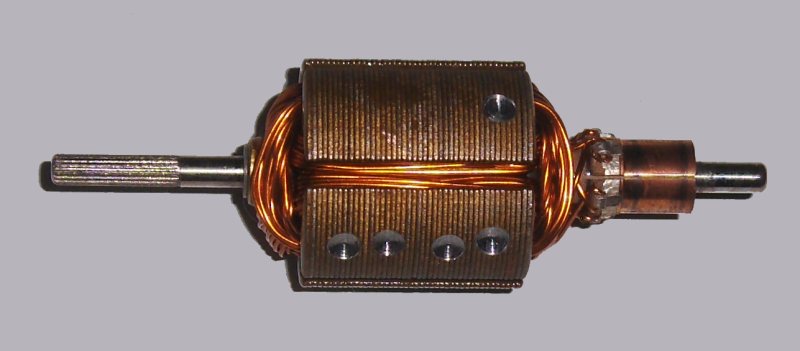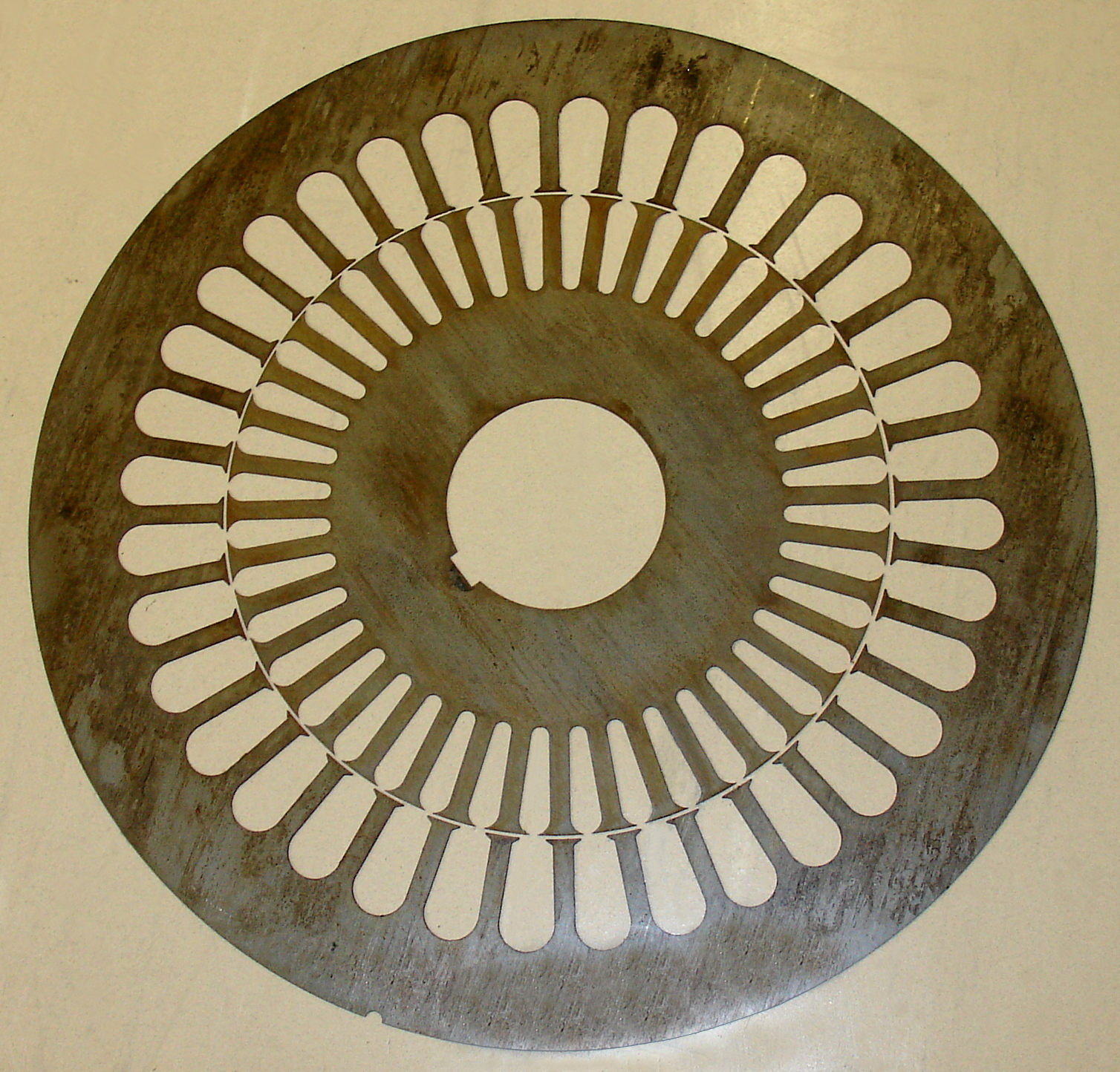|
Winding Factor
In power engineering, winding factor k_w provides a way to compare of the effectiveness of different designs of stators for alternators. Winding factor is the ratio of electromotive force (EMF) produced by a stator having a short-pitch, distributed, or skewed winding, with a stator having full-pitch, concentrated, and non-skewed, windings. For most alternators, the stator acts as the armature. Winding factor also applies to other electric machines, but this article focuses on winding factor as it applies to alternators. Practical alternators have a short-pitched and distributed windings to reduce harmonics and maintain constant torque. Also, either the stator or rotor may be slightly skewed from the rotor's axis to reduce cogging torque. The armature winding of each phase may be distributed in a number of pole slots. Since the EMF induced in different slots are not in phase, their phasor sum is less than their numerical sum. This reduction factor is called distribution ... [...More Info...] [...Related Items...] OR: [Wikipedia] [Google] [Baidu] |
Power Engineering
Power engineering, also called power systems engineering, is a subfield of electrical engineering that deals with the generation, transmission, distribution, and utilization of electric power, and the electrical apparatus connected to such systems. Although much of the field is concerned with the problems of three-phase AC power – the standard for large-scale power transmission and distribution across the modern world – a significant fraction of the field is concerned with the conversion between AC and DC power and the development of specialized power systems such as those used in aircraft or for electric railway networks. Power engineering draws the majority of its theoretical base from electrical engineering. History Pioneering years Electricity became a subject of scientific interest in the late 17th century. Over the next two centuries a number of important discoveries were made including the incandescent light bulb and the voltaic pile. Probably the greatest dis ... [...More Info...] [...Related Items...] OR: [Wikipedia] [Google] [Baidu] |
Alternators
An alternator is an electrical generator that converts mechanical energy to electrical energy in the form of alternating current. For reasons of cost and simplicity, most alternators use a rotating magnetic field with a stationary armature.Gordon R. Selmon, ''Magnetoelectric Devices'', John Wiley and Sons, 1966 no ISBN pp. 391-393 Occasionally, a linear alternator or a rotating armature with a stationary magnetic field is used. In principle, any AC electrical generator can be called an alternator, but usually the term refers to small rotating machines driven by automotive and other internal combustion engines. An alternator that uses a permanent magnet for its magnetic field is called a magneto. Alternators in power stations driven by steam turbines are called turbo-alternators. Large 50 or 60 Hz three-phase alternators in power plants generate most of the world's electric power, which is distributed by electric power grids. History Alternating current generating syste ... [...More Info...] [...Related Items...] OR: [Wikipedia] [Google] [Baidu] |
Electromotive Force
In electromagnetism and electronics, electromotive force (also electromotance, abbreviated emf, denoted \mathcal or ) is an energy transfer to an electric circuit per unit of electric charge, measured in volts. Devices called electrical ''transducers'' provide an emf by converting other forms of energy into electrical energy. Other electrical equipment also produce an emf, such as batteries, which convert chemical energy, and generators, which convert mechanical energy. This energy conversion is achieved by physical forces applying physical work on electric charges. However, electromotive force itself is not a physical force, and for the current ISO/IEC standards consider the term deprecated, favoring the names source voltage or source tension instead (denoted U_s). An electronic–hydraulic analogy may view emf as the mechanical work done to water by a pump, which results in a pressure difference (analogous to voltage). In electromagnetic induction, emf can be defined ar ... [...More Info...] [...Related Items...] OR: [Wikipedia] [Google] [Baidu] |
Armature (electrical Engineering)
In electrical engineering, the armature is the winding (or set of windings) of an electric machine which carries alternating current. The armature windings conduct AC even on DC machines, due to the commutator action (which periodically reverses current direction) or due to electronic commutation, as in brushless DC motors. The armature can be on either the rotor (rotating part) or the stator (stationary part), depending on the type of electric machine. The armature windings interact with the magnetic field ( magnetic flux) in the air-gap; the magnetic field is generated either by permanent magnets, or electromagnets formed by a conducting coil. The armature must carry current, so it is always a conductor or a conductive coil, oriented normal to both the field and to the direction of motion, torque (rotating machine), or force (linear machine). The armature's role is twofold. The first is to carry current across the field, thus creating shaft torque in a rotating machine or ... [...More Info...] [...Related Items...] OR: [Wikipedia] [Google] [Baidu] |
Electric Machines
In electrical engineering, electric machine is a general term for machines using electromagnetic forces, such as electric motors, electric generators, and others. They are electromechanical energy converters: an electric motor converts electricity to mechanical power while an electric generator converts mechanical power to electricity. The moving parts in a machine can be rotating (''rotating machines'') or linear (''linear machines''). Besides motors and generators, a third category often included is transformers, which although they do not have any moving parts are also energy converters, changing the voltage level of an alternating current.Flanagan. Handbook of Transformer Design and Applications, Chap. 1 p1. Electric machines, in the form of generators, produce virtually all electric power on Earth, and in the form of electric motors consume approximately 60% of all electric power produced. Electric machines were developed beginning in the mid 19th century and since that ti ... [...More Info...] [...Related Items...] OR: [Wikipedia] [Google] [Baidu] |
Cogging Torque
Cogging torque of electrical motors is the torque due to the interaction between the permanent magnets of the rotor and the stator slots of a permanent magnet machine. It is also known as ''detent'' or ''no-current torque''. This torque is position dependent and its periodicity per revolution depends on the number of magnetic poles and the number of teeth on the stator. Cogging torque is an undesirable component for the operation of such a motor. It is especially prominent at lower speeds, with the symptom of jerkiness. Cogging torque results in torque as well as speed ripple; however, at high speed the motor moment of inertia filters out the effect of cogging torque. Reducing the cogging torque A summary of techniques used for reducing cogging torque: * Skewing stator stack or magnets * Using fractional slots per pole * Optimizing the magnet pole arc or width Almost all the techniques used against cogging torque also reduce the motor counter-electromotive force and so reduce the ... [...More Info...] [...Related Items...] OR: [Wikipedia] [Google] [Baidu] |
Angle
In Euclidean geometry, an angle is the figure formed by two Ray (geometry), rays, called the ''Side (plane geometry), sides'' of the angle, sharing a common endpoint, called the ''vertex (geometry), vertex'' of the angle. Angles formed by two rays lie in the plane (geometry), plane that contains the rays. Angles are also formed by the intersection of two planes. These are called dihedral angles. Two intersecting curves may also define an angle, which is the angle of the rays lying tangent to the respective curves at their point of intersection. ''Angle'' is also used to designate the measurement, measure of an angle or of a Rotation (mathematics), rotation. This measure is the ratio of the length of a arc (geometry), circular arc to its radius. In the case of a geometric angle, the arc is centered at the vertex and delimited by the sides. In the case of a rotation, the arc is centered at the center of the rotation and delimited by any other point and its image by the rotation ... [...More Info...] [...Related Items...] OR: [Wikipedia] [Google] [Baidu] |
Electrical Degrees
In electrical engineering, coil winding is the manufacture of electromagnetic coils. Coils are used as components of circuits, and to provide the magnetic field of motors, transformers, and generators, and in the manufacture of loudspeakers and microphones. The shape and dimensions of a winding are designed to fulfill the particular purpose. Parameters such as inductance, Q factor, insulation strength, and strength of the desired magnetic field greatly influence the design of coil windings. Coil winding can be structured into several groups regarding the type and geometry of the wound coil. Mass production of electromagnetic coils relies on automated machinery. Terminology related to electric machines This article is about coil winding technology and much of the article is specific to electric machines. This section provides definitions of terms used later in the article. Rotor and stator An electric motor or generator consists of a cylinderical rotating part called the ''r ... [...More Info...] [...Related Items...] OR: [Wikipedia] [Google] [Baidu] |
Chord (geometry)
A chord of a circle is a straight line segment whose endpoints both lie on a circular arc. The infinite line extension of a chord is a secant line, or just ''secant''. More generally, a chord is a line segment joining two points on any curve, for instance, an ellipse. A chord that passes through a circle's center point is the circle's diameter. The word ''chord'' is from the Latin ''chorda'' meaning '' bowstring''. In circles Among properties of chords of a circle are the following: # Chords are equidistant from the center if and only if their lengths are equal. # Equal chords are subtended by equal angles from the center of the circle. # A chord that passes through the center of a circle is called a diameter and is the longest chord of that specific circle. # If the line extensions (secant lines) of chords AB and CD intersect at a point P, then their lengths satisfy AP·PB = CP·PD (power of a point theorem). In conics The midpoints of a set of parallel chords of a coni ... [...More Info...] [...Related Items...] OR: [Wikipedia] [Google] [Baidu] |
Harmonics (electrical Power)
In an electric power system, a harmonic of a voltage or current waveform is a sinusoidal wave whose frequency is an integer multiple of the fundamental frequency. Harmonic frequencies are produced by the action of non-linear loads such as rectifiers, discharge lighting, or saturated electric machines. They are a frequent cause of power quality problems and can result in increased equipment and conductor heating, misfiring in variable speed drives, and torque pulsations in motors and generators. Harmonics are usually classified by two different criteria: the type of signal (voltage or current), and the order of the harmonic (even, odd, triplen, or non-triplen odd); in a three-phase system, they can be further classified according to their phase sequence (positive, negative, zero). Current harmonics In a normal alternating current power system, the current varies sinusoidally at a specific frequency, usually 50 or 60 hertz. When a linear time-invariant electrical load is connected ... [...More Info...] [...Related Items...] OR: [Wikipedia] [Google] [Baidu] |





